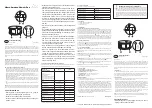
Glossary
Glossary
General Terms
RPCM
—
Resilient Power Control Module
— a device combining the functions of power moni-
toring, automatic transfer switch (ATS) without interrupting the operation of the connected
equipment, short-circuit protection and power metering on each port.
Serial Name
— unique device name
RPCM
for easy identification during maintenance and tech-
nical support.
Serial Number
— serial number of the device
Front Panel
— front plane of the device case with the indicating and operating elements located
on it.
Back Panel
— rear plane of the device housing the connectors for outlets and and inputs fixed to
it.
Input
— physical input channel through which power is supplied to the device.
Inlet
— (see
Input
)
Outlet
— a physical channel for connection of the powered equipment. Only 10 channels from
0
to
9
with the functions of flexible control and monitoring.
Output
— (see
Outlet
)
RTC
— Real Time Clock
ATS
— Automatic Transfer Switch; a functionality that detects absence of voltage on main power
input or degradation of power input quality and switches consumers over to the reserve power
input.
Recognition
— an object identification. For power management, you need to accurately identify
the object: a separate input, output, or the entire RPCM. To solve this problem, a backlight or a
sound signal (beeper) can be used.
Administrative status
— the object status as defined by the RPCM administrator (user). “
Administra-
tively off”
means
that the power supply has been turn off by the administrator. The state
"administra-
tively on, hardware off"
means that, according to the administrative settings, power should be sup-
plied, but it was interrupted at the hardware level, for example, an overload or short circuit protection
of the RPCM was triggered.
“Cold” start
— start power to the RPCM from an external source after a complete shutdown. A
“cold” restart
terminates and resumes power to the RPCM outlets.
333





































